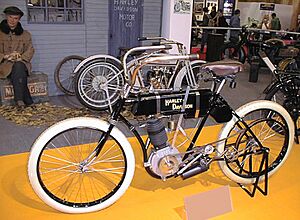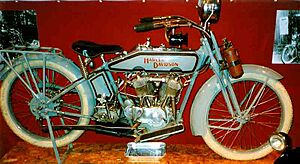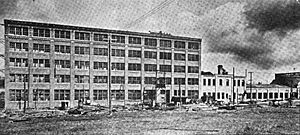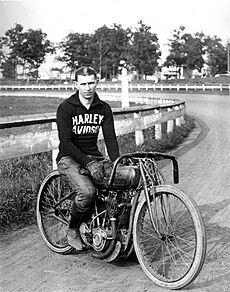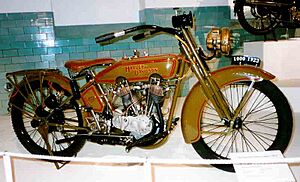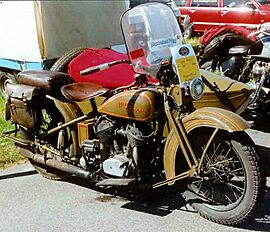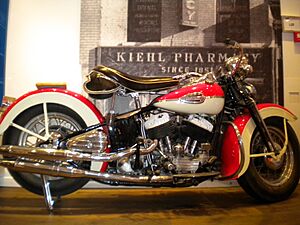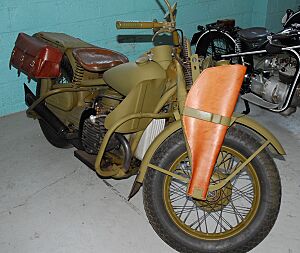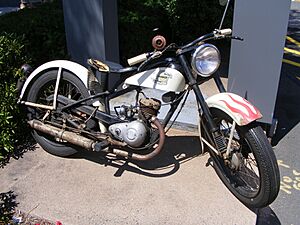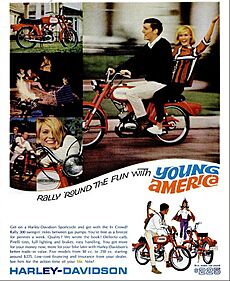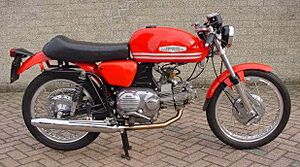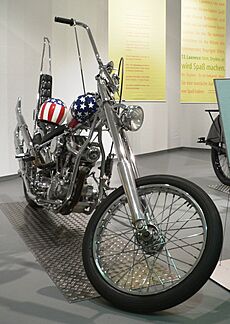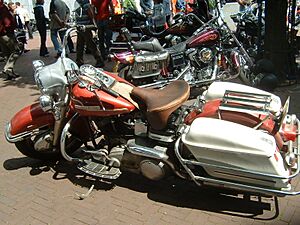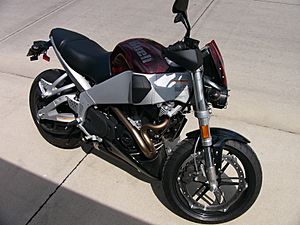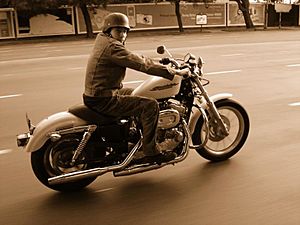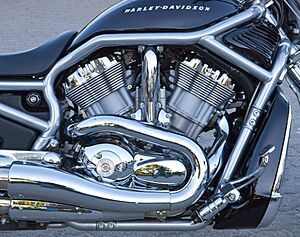Harley-Davidson facts for kids
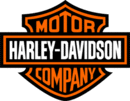 |
|
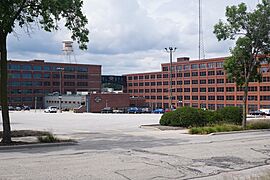
Harley-Davidson headquarters in Milwaukee
|
|
| Public | |
| Traded as |
|
| ISIN | [https://isin.toolforge.org/?language=en&isin=US4128221086 US4128221086] |
| Industry | Automotive |
| Founded | 1903 |
| Founder |
|
| Headquarters | Milwaukee, Wisconsin, U.S. 43°02′46″N 87°57′36″W / 43.04611°N 87.96000°W |
|
Key people
|
Jochen Zeitz (CEO and chairman) |
| Products | Motorcycles |
|
Production output
|
|
| Revenue | |
|
Operating income
|
|
| Total assets | |
| Total equity | |
|
Number of employees
|
c. 6,400 (2023) |
| Subsidiaries |
|
Harley-Davidson, Inc. (often called H-D or just Harley) is a famous American company that makes motorcycles. Its main office is in Milwaukee, Wisconsin. The company started in 1903. It is one of only two big American motorcycle makers that survived the Great Depression. Its main competitor was Indian Motorcycles.
Harley-Davidson has gone through many changes in ownership and faced tough competition. But it has become a well-known brand with many loyal fans. There are Harley-Davidson clubs and events all over the world. The company also has a museum dedicated to its brand.
Harley-Davidson is known for a special way of customizing motorcycles called the chopper style. The company traditionally sold large, air-cooled cruiser motorcycles. These bikes had engines bigger than 700 cubic centimeters. More recently, Harley has also started making modern bikes like the VRSC (since 2002) and mid-size Street (since 2014) models.
Harley-Davidson builds its motorcycles in factories in places like York, Pennsylvania; Menomonee Falls, Wisconsin; Tomahawk, Wisconsin; Manaus, Brazil; and Rayong, Thailand. The company sells its products worldwide. It also sells many other items with the Harley-Davidson brand. These include clothes, home decorations, accessories, toys, model motorcycles, and video games.
Contents
- Harley-Davidson's Story
- Early Days and First Bikes
- Building the First Factory
- Harley-Davidson in World War I
- The 1920s: Growth and New Features
- Surviving the Great Depression
- Harley-Davidson in World War II
- Smaller Bikes: Hummer and Aermacchi
- Challenges and a New Start
- Fat Boy and the Harley-Davidson Museum
- International Growth
- Buell Motorcycles
- Challenges and Changes
- Harley-Davidson Engines
- Harley-Davidson Motorcycle Families
- Custom Vehicle Operations (CVO)
- Harley-Davidson and the Environment
- Harley-Davidson Culture
- See also
Harley-Davidson's Story
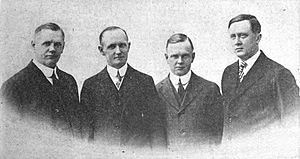
Early Days and First Bikes
In 1901, a 20-year-old named William S. Harley drew plans for a small engine. It was meant to be used in a regular bicycle frame. For the next two years, he and his friend Arthur Davidson worked on their "motor-bicycle." They used a machine shop at their friend Henry Melk's home in Milwaukee.
The bike was finished in 1903 with help from Arthur's brother, Walter Davidson. When they tested it, Harley and the Davidson brothers found it couldn't climb hills around Milwaukee without pedaling. They learned a lot from this first attempt.
The three friends then started working on a better machine. It had a larger engine and heavier parts. Its advanced design was similar to other motorcycles of that time. This bigger engine and frame meant it was no longer just a motorized bicycle. It set the path for future motorcycle designs. They also got help from Ole Evinrude, who was building gas engines for cars.
The first new Harley-Davidson was put together in a small shed in the Davidson family's backyard. Most of the main parts were made elsewhere. Some were likely made at the West Milwaukee rail shops. William A. Davidson, the oldest brother, was a foreman there. This first bike was ready by September 8, 1904. It even raced in a Milwaukee motorcycle race and came in fourth place.
In January 1905, the company started advertising its engines for people to build their own bikes. By April, they were making a few complete motorcycles. That year, a dealer in Chicago sold three bikes from the five made in the backyard shed. Years later, the company moved the original shed to its main factory as a tribute.
Building the First Factory
In 1906, Harley and the Davidson brothers built their first factory. It was on Chestnut Street, which is now Juneau Avenue. This is still where Harley-Davidson's main office is today. The first factory was a small, one-story wooden building. That year, the company made about 50 motorcycles.
In 1907, William S. Harley finished college with a degree in mechanical engineering. That year, they added a second floor to the factory. They also added cream-colored brick to the outside. With these new additions, production grew to 150 motorcycles in 1907. The company officially became a corporation that September. They also started selling motorcycles to police departments. This has been an important market for them ever since. In 1907, William A. Davidson joined the company full-time.
In 1905 and 1906, all bikes were single-cylinder models. In February 1907, they showed a new type of engine at a car show. It was a V-Twin engine, which means it had two cylinders shaped like a "V." Very few V-Twin models were built between 1907 and 1910. These first V-Twins were more powerful. Production jumped from 450 motorcycles in 1908 to 1,149 in 1909.
In 1911, the company introduced an improved V-Twin model. It was smaller than earlier V-Twins but performed better. After 1913, most bikes made by Harley-Davidson were V-Twin models.
In 1912, Harley-Davidson introduced a special "Ful-Floteing Seat." This seat had a spring inside that could be adjusted for the rider's weight. This made the ride much smoother. Harley-Davidson used these types of seats until 1958.
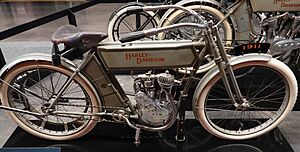
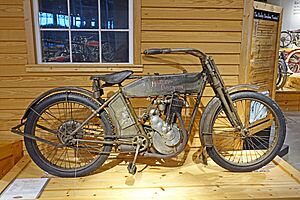

By 1913, the old factory was replaced by a new, much larger building. It was five stories tall and covered two city blocks. Harley-Davidson was becoming a leader in motorcycle racing after 1914. Production grew to 16,284 machines that year.
Harley-Davidson in World War I
In 1917, the United States joined World War I. The military needed motorcycles for the war. Harleys had been used by the military before, but this was the first time they were widely adopted. The U.S. military bought over 20,000 motorcycles from Harley-Davidson.
Harley-Davidson also started selling bicycles in 1917. They hoped to get more customers for their motorcycles. But sales were not good, and they stopped making bicycles in 1923.
The 1920s: Growth and New Features
By 1920, Harley-Davidson was the biggest motorcycle maker in the world. They produced over 28,000 machines and had dealers in 67 countries. In 1921, a rider named Otto Walker set a record on a Harley-Davidson. He was the first to win a race at an average speed faster than 100 miles per hour.
Harley-Davidson made several improvements in the 1920s. They introduced a new V-Twin engine in 1921. In 1925, they added the famous "teardrop" shaped gas tank. They also added a front brake in 1928 on some models. In 1929, Harley-Davidson introduced a smaller V-Twin engine. This was to compete with other popular motorcycles.
Surviving the Great Depression
The Great Depression started shortly after Harley-Davidson introduced its new model. Sales dropped sharply, from 21,000 bikes in 1929 to just 3,703 in 1933. Even with this challenge, Harley-Davidson showed off new models for 1934. These bikes had a new engine type and cool Art Deco designs.
To survive, the company also made industrial engines based on their motorcycle engines. They also designed a three-wheeled delivery vehicle called the Servi-Car. This vehicle was made until 1973.
In the mid-1930s, a production line for Harley-Davidson bikes opened in Japan. The Japanese company, Sankyo Seiyaku Corporation, later stopped working with Harley-Davidson. They continued making the bikes under the name Rikuo.
In 1936, Harley-Davidson introduced new models with the "Knucklehead" engine. This engine had a special design where valves were above the cylinders. There were some early problems with these engines, but they were quickly fixed.
By 1937, all Harley-Davidson engines had a new oil system. This system helped the engines run better.
Harley-Davidson in World War II
Harley-Davidson was one of only two American motorcycle makers to survive the Great Depression. During World War II, they again made many motorcycles for the U.S. Army. After the war, they went back to making bikes for regular buyers. These large V-twin motorcycles were very popular.
Before World War II, Harley-Davidson was already supplying the Army with a special military version of its bikes. When the war started, the company focused on war production. They made about 90,000 military motorcycles, mostly for the U.S. and its allies. Harley-Davidson received awards for its excellent production during the war.
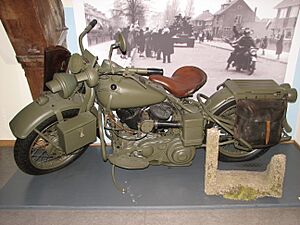
About 30,000 bikes were sent to the Soviet Union to help with the war effort. Production of the military bikes stopped at the end of World War II. However, it started again from 1949 to 1952 for the Korean War.
The U.S. Army also asked Harley-Davidson to make a new motorcycle. It was to have features similar to a German BMW motorcycle. Harley-Davidson copied the BMW engine and design. They produced the Harley-Davidson XA model in 1942 and 1943. This bike had a different engine design than other Harleys. The XA never went into full production. By then, the Jeep had become the Army's main vehicle.
Smaller Bikes: Hummer and Aermacchi
After World War II, Harley-Davidson got the design for a small German motorcycle. They made and sold this bike from 1948 to 1966. Different models were made, but people often call them all "Hummers."
In 1960, Harley-Davidson bought half of an Italian motorcycle company called Aermacchi. They started selling Aermacchi's 250 cc motorcycles in the U.S. under the Harley-Davidson name. These bikes were called the Harley-Davidson Sprint. Harley-Davidson later bought full control of Aermacchi's motorcycle production in 1974. They continued making two-stroke motorcycles there until 1978.
Challenges and a New Start
In 1969, a company called American Machine and Foundry (AMF) bought Harley-Davidson. AMF tried to make production faster and cut down on workers. This led to a worker strike. Also, cutting costs led to lower quality bikes. At the same time, big Japanese motorcycle companies like Honda and Yamaha introduced new, high-quality motorcycles. Compared to these, Harley-Davidson bikes were expensive and not as good. Sales and quality dropped, and the company almost went out of business. People even made fun of the Harley-Davidson name.
In 1981, AMF sold the company to a group of 13 investors. This group was led by Vaughn Beals and Willie G. Davidson. The new leaders worked to make the bikes better. They used new technologies and improved how they managed their inventory. They also asked the government for help against the strong competition from Japanese manufacturers. The government agreed in 1983, which gave Harley-Davidson time to improve.
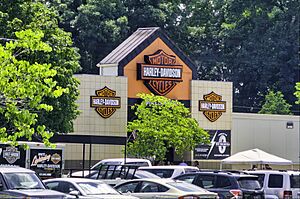
A key part of Harley-Davidson's comeback was changing its bike designs. Instead of copying Japanese styles, the new leaders decided to focus on Harley's classic look. They made bikes that looked and felt like older Harleys. Many parts, like brakes and wheels, were bought from other companies, which helped improve quality. Buyers slowly started coming back.
Harley-Davidson also bought a special rear suspension design. They used it to create their Softail series of motorcycles, which came out in 1984.
Fat Boy and the Harley-Davidson Museum
By 1990, with the introduction of the "Fat Boy", Harley-Davidson was again the top seller of large motorcycles. The name "Fat Boy" came from how wide the motorcycle looked from the front.
In 1993 and 1994, the FXR models were replaced by the Dyna (FXD) models.
Harley-Davidson celebrated its 100th anniversary on September 1, 2003. They had a big event and concert with famous musicians.
Construction started on the Harley-Davidson Museum in Milwaukee, Wisconsin, on June 1, 2006. It cost $75 million and opened in 2008. The museum holds the company's large collection of old motorcycles and company records. It also has a restaurant and meeting spaces.
International Growth
The oldest Harley-Davidson dealership outside the United States opened in Australia in 1918. Sales in Japan started in 1912. Later, Harley-Davidsons were made in Japan under a license by the company Rikuo.
In 1998, the first Harley-Davidson factory outside the U.S. opened in Manaus, Brazil. This factory helped sell motorcycles in the southern part of the world.
In August 2009, Harley-Davidson started selling motorcycles in India. However, on September 24, 2020, Harley-Davidson announced it would stop selling and making bikes in India. This was because of low demand and sales.
Buell Motorcycles
Harley-Davidson started working with sportbike maker Buell Motorcycle Company in 1987. Harley-Davidson bought 49 percent of Buell in 1993, and then took full ownership in 2003.
Buell developed a low-cost, easy-to-maintain motorcycle to attract new riders. This bike, the single-cylinder Buell Blast, was introduced in 2000. It was used as a training bike for Harley-Davidson's Rider's Edge course until 2014. Over 350,000 people learned to ride on the Buell Blast.
On October 15, 2009, Harley-Davidson announced it would stop making Buell motorcycles. They wanted to focus only on the Harley-Davidson brand. The company decided not to sell Buell to anyone else.
Challenges and Changes
Around 2000, some police departments reported problems with Harley-Davidson Touring motorcycles at high speeds. A police officer was killed in a crash that was reportedly due to a "high-speed wobble."
On February 2, 2007, about 2,700 workers at Harley-Davidson's largest factory in York, Pennsylvania, went on strike. They could not agree on wages and health benefits. The strike stopped production across the company. On February 16, 2007, Harley-Davidson reached an agreement with the workers, and the strike ended.
On July 11, 2008, Harley-Davidson announced it would buy the MV Agusta Group, an Italian motorcycle company. However, on October 15, 2009, Harley-Davidson decided to sell MV Agusta back to its former owner.
The 2008 financial crisis also affected the motorcycle industry. The value of the Harley-Davidson brand dropped. In 2010, Harley-Davidson announced it needed to cut costs. They closed two factories and planned to reduce their workforce. However, on September 14, 2010, the company announced it would keep its main operations in Wisconsin.
Harley-Davidson Engines
Classic Harley-Davidson engines are V-twin engines. This means they have two cylinders arranged in a "V" shape, with a 45-degree angle between them. Both pistons are connected to a single pin.
This 45-degree angle is special to Harley-Davidson. It allows for a powerful engine in a smaller space. It also makes the cylinders fire at uneven times. This creates the unique "potato-potato" sound that Harley-Davidson is famous for.
The engine's design uses a simple ignition system. This makes both spark plugs fire at the same time, even if only one cylinder needs it. This is called a "wasted spark" system. The sound of the exhaust is a deep growl with some popping.
Harley-Davidson has used different ignition systems over the years. Since 1995, the company has offered Electronic Fuel Injection (EFI) as an option. EFI became standard on all Harley-Davidson motorcycles starting with the 2007 models.
In 1994, the company tried to trademark the special sound of its engine. However, other motorcycle companies argued that their V-twin engines made a similar sound. In 2000, Harley-Davidson stopped trying to trademark the sound.
Big V-Twin Engines
Harley-Davidson has used many different big V-twin engines over the years. Each one has a special nickname:
- F-head (also called JD or IOE), 1914–1929
- Flathead, 1930–1949
- Knucklehead, 1936–1947
- Panhead, 1948–1965
- Shovelhead, 1966–1984
- Evolution (or "Evo" and "Blockhead"), 1984–1999
- Twin Cam (or "Fathead"), 1999–2017. This engine came in different sizes, like 88, 95, 96, 103, and 110 cubic inches.
- Milwaukee-Eight, since 2017. This engine also comes in different sizes.
Small V-Twin Engines
Harley-Davidson has also made smaller V-twin engines for certain models:
- D Model, 1929–1931
- R Model, 1932–1936
- Flathead 750 cc, 1937–1973 (used in the Servi-Car)
- K Model, 1952–1953
- KH Model, 1954–1956
- Ironhead, 1957–1985
- Evolution, since 1986, in 883 cc, 1,100 cc, and 1,200 cc sizes.
Revolution Engine
The Revolution engine is a special liquid-cooled V-twin engine. It was developed with help from Porsche. It was first used in the new VRSC (V-Rod) line in 2001 for the 2002 model year. This engine was a big change from Harley's traditional designs.
A more powerful version of the Revolution engine was available for some models. In 2008, the 1,250 cc Revolution Engine became standard for the entire VRSC line.
Smaller 750 cc and 500 cc versions of the Revolution engine are used in Harley-Davidson's Street line of lighter motorcycles. These are called the Revolution X engines.
Harley-Davidson Motorcycle Families
Modern Harley-Davidson motorcycles fit into different groups or "families." These families are different based on their frame, engine, suspension, and other features.
Touring Models
Touring models use big engines and large front forks. All Touring models have names that start with "FL," like FLHR (Road King) and FLTR (Road Glide).
These bikes are also called "dressers" or "baggers" because they have large saddlebags. They include models like Road King, Road Glide, Electra Glide, and Street Glide. Road Kings have a classic "retro cruiser" look with a big windshield. Electra Glides have a full front fairing, often called the "Batwing" because of its shape. Road Glide models have a fairing attached to the frame, called the "Sharknose."
Touring models are known for their large saddlebags and air suspension in the back. They are the only models that offer full fairings with radios. All touring models use a similar frame design that has been updated over the years. This frame helps reduce engine vibration for the rider.
In 2006, Harley introduced the FLHX Street Glide. In 2008, Harley added anti-lock braking systems (ABS) and cruise control as options on all touring models. They also added a larger fuel tank.
For the 2009 model year, Harley-Davidson updated the entire touring line. They made changes to the frame, swingarm, and engine-mounting system. These changes made the bikes better for carrying loads, easier to handle, and smoother to ride. Also in 2009, Harley released the FLHTCUTG Tri-Glide Ultra Classic, which is a three-wheeled Harley.
In 2014, Harley-Davidson updated some touring bikes as part of "Project Rushmore." These updates included a new engine, easy-open saddlebags, and a new entertainment system with touchscreens and Bluetooth. Other features included ABS brakes and improved comfort for riders and passengers.
Softail Models
These motorcycles are designed to look like older "hardtail" bikes from the 1960s and 1970s. The rear suspension is hidden under the transmission, giving them a clean, classic look. Harley offers Softail models with "Heritage" styling that uses design ideas from their long history.
Softail models use the big-twin engine and the Softail frame. Their names usually start with "FXST" for models with 21-inch front wheels, or "FLST" for models with 16-inch front wheels. Examples include the FLSTF (Fat Boy) and FLSTC (Heritage Softail Classic).
Dyna Models
Dyna-frame motorcycles were developed in the 1980s and 1990s. They first appeared in 1991. The Dyna frame uses big-twin engines and has a traditional style. You can tell them apart from Softail models by their visible coil-over suspension that connects the swingarm to the frame. They are different from Sportsters because they have larger engines.
Dyna models usually had a narrow front fork and front wheel. This group included models like the Super Glide (FXD) and Low Rider (FXDL). In 2008, the Dyna Fat Bob (FXDF) was introduced with a more aggressive look. In 2012, the Dyna Switchback (FLD) became the first Dyna model to have floorboards and detachable saddlebags.
Dyna models used the 88-cubic-inch Twin Cam engine from 1999 to 2006. In 2007, the engine size increased to 96 cubic inches. By 2012, many Dyna models were offered with the 103-cubic-inch engine. All Dyna models have an engine that is mounted with rubber to reduce vibration. Harley stopped making the Dyna platform in 2017. Some of these models were then moved to the new Softail line.
Dyna model names usually start with "FXD," like FXDWG (Dyna Wide Glide).
Sportster Models
The Sportster family was introduced in 1957. These bikes were first designed for racing and were popular on dirt tracks. Sportsters are smaller and lighter than other Harley models. Modern Sportsters use 883 cc or 1,200 cc Evolution engines. They still look similar to their racing ancestors.
Before 2004, the Sportster engine was directly attached to the frame. In 2004, the Sportster got a new frame with a rubber-mounted engine. This made the bike heavier but greatly reduced vibration, making the ride smoother.
In 2007, Harley-Davidson celebrated the Sportster's 50th anniversary. They made a special limited edition called the XL50. Also in 2007, electronic fuel injection was added to the Sportster family. In 2009, the Iron 883 was added to the Sportster line.
In 2008, Harley-Davidson released the XR1200 Sportster in Europe. It had a powerful Evolution engine and special brakes. It was later released in the United States in 2009. The XR1200 was stopped in 2013.
In 2021, Harley-Davidson launched the Sportster S model. It has a powerful 121 hp engine and new safety features like cornering-ABS. The Sportster S is the first Sportster model since 1957 to have a completely new engine.
Most Sportster models for street use have names that start with "XL." Models with the smaller engine are called XL883. Models with the larger engine are called XL1200.
VRSC Models
The VRSC family of "muscle bikes" was introduced in 2001 and made until 2017. These bikes look very different from traditional Harleys. They use the Revolution engine, which was the first Harley engine to have overhead cams and liquid cooling. The V-Rod bikes are easy to spot because of their 60-degree V-Twin engine and radiator.
In 2008, Harley added ABS as an option on all VRSC models. They also increased the engine size to 1,250 cc.
VRSC model names include VRSCA (V-Rod), VRSCD (Night Rod), and VRSCF (V-Rod Muscle).
Street Models
The Street is Harley-Davidson's newest type of motorcycle. It was designed to attract younger riders who want a lighter, more affordable bike. The Street 750 model was launched in India in 2014. It is one of the lightest Harley-Davidson motorcycles available.
The Street 750 uses a new liquid-cooled V-twin engine called the Revolution X. This engine is 749 cc and has a six-speed transmission.
The Street 750 and the smaller Street 500 have been available since late 2014. Street series motorcycles for North America are built in Harley-Davidson's Kansas City, Missouri plant. Bikes for other parts of the world are built in India.
LiveWire Models
Harley-Davidson's LiveWire, released in 2019, is their first electric motorcycle. It has a high-voltage battery that allows it to travel at least 98 miles in the city. The LiveWire is aimed at a different type of customer than their classic V-twin bikes.
In March 2020, a Harley-Davidson LiveWire was used to break the 24-hour distance record for an electric motorcycle. The bike traveled over 1,000 miles in less than 24 hours. The LiveWire can be charged slowly at home or quickly at a special DC Fast Charge station.
In December 2021, the company announced that LiveWire would become its own separate company.
Custom Vehicle Operations (CVO)
Custom Vehicle Operations (CVO) is a special team at Harley-Davidson. They create limited-edition custom versions of Harley's regular models. Every year since 1999, this team picks a few models. They add bigger engines, performance upgrades, special paint, more chrome, and better sound systems. These CVO bikes are high-quality, premium custom motorcycles.
Harley-Davidson and the Environment
The Environmental Protection Agency (EPA) works to protect the environment. In 2005, Harley-Davidson worked with the EPA to ensure their vehicles meet environmental standards. Harley-Davidson also became the first company to join a special program to clean up soil and groundwater at one of its old factory sites.
In 2016, Harley-Davidson reached an agreement with the EPA. This was about "super tuners" that could change how their motorcycles' engines worked. These devices could increase performance but also caused more pollution. Harley-Davidson agreed to buy back and destroy any super tuners that did not meet clean air rules. They also agreed to spend money on reducing air pollution.
Harley-Davidson Culture
Harley-Davidson has a very loyal group of fans. Many Harley-Davidson Clubs exist around the world. The oldest one, started in 1928, is in Prague. The company also makes money by licensing its logo for clothing and other items. Many American police forces use Harley-Davidson motorcycles.
For a long time, Harley-Davidson tried to show its motorcycles as proper and refined. But in the 1960s, they started to embrace a more tough and independent image. Their marketing focused on the "bad boy" image often linked to bikers and motorcycle clubs.
The "Hog" Nickname
Starting in 1920, a team of young farm boys who raced Harleys became known as the "hog boys." They had a live hog as their team mascot. After winning a race, they would put the hog on their Harley and ride around. In 1983, the company started a club for Harley owners called HOG, which stands for Harley Owners Group.
Harley-Davidson tried to trademark the word "hog." But in 1999, a court ruled that "hog" had become a general term for large motorcycles. So, it could not be trademarked. On August 15, 2006, Harley-Davidson Inc. changed its stock market symbol to HOG.
Bobbers
Harley-Davidson FL "big twins" usually had heavy steel fenders and lots of chrome. After World War II, riders who wanted more speed would often shorten or remove the fenders to make the motorcycle lighter. These bikes were called "bobbers" or sometimes "choppers."
Harley Owners Group (HOG)
Harley-Davidson created the Harley Owners Group (HOG) in 1983. This was to build on the loyalty of its fans and promote a lifestyle around its products. HOG also created new ways for the company to make money, like selling special merchandise to club members. Other motorcycle brands and companies have tried to create similar clubs.
HOG members often spend more money on things like clothing and Harley-Davidson events. In 1991, HOG became international. Today, it has over one million members and more than 1,400 chapters worldwide. This makes HOG the largest company-sponsored motorcycle organization in the world.
HOG members get benefits like organized group rides, special products, and discounts. A one-year membership is included when you buy a new Harley-Davidson.
In 2008, HOG celebrated its 25th anniversary with Harley's 105th anniversary in Milwaukee.
Factory Tours and Museum
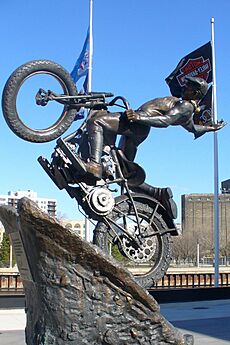
Harley-Davidson offers tours at some of its factories. The Harley-Davidson Museum, which opened in 2008, shows the history, culture, and vehicles of Harley-Davidson. It also has the company's old records, a restaurant, and a store.
You can visit these locations:
- York, Pennsylvania – Where Touring, Softail, and custom bikes are made.
- Tomahawk, Wisconsin – Where sidecars, saddlebags, and windshields are made.
- Kansas City, Missouri – Where Sportster, VRSC, and other vehicles are made.
- Menomonee Falls, Wisconsin – A plant that makes engines, offering two types of tours.
- Milwaukee, Wisconsin – The Harley-Davidson Museum.
Anniversary Celebrations
Since its 90th anniversary in 1993, Harley-Davidson has had special rides to Milwaukee called the "Ride Home." This tradition happens every five years and is sometimes called "Harleyfest." It brings Harley riders from all over the world. The 105th anniversary was held in August 2008. The 110th anniversary was held in August 2013. The 115th anniversary was held in Prague, Czech Republic, in July 2018. It attracted over 100,000 visitors. The 120th anniversary was held in Budapest, Hungary, in June 2023.
Labor Hall of Fame
In 2004, the founders William S. Harley, Arthur Davidson, William A. Davidson, and Walter Davidson Sr. were honored. They were inducted into the Labor Hall of Fame for their achievements with the Harley-Davidson company and its workers.
Television Show
The story of the company's beginnings was made into a TV show in 2016 called Harley and the Davidsons. It showed the lives of William Harley, Arthur Davidson, and Walter Davidson. The show was first shown on the Discovery Channel.
See also
 In Spanish: Harley-Davidson para niños
In Spanish: Harley-Davidson para niños
- List of Harley-Davidson motorcycles
- Category:Harley-Davidson engines
- Harley-Davidson (Bally pinball)
- Harley-Davidson (Sega/Stern pinball)
- Harley-Davidson & L.A. Riders
- Harley-Davidson: Race Across America
- List of motor scooter manufacturers and brands


